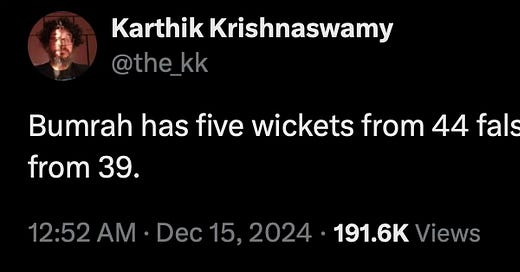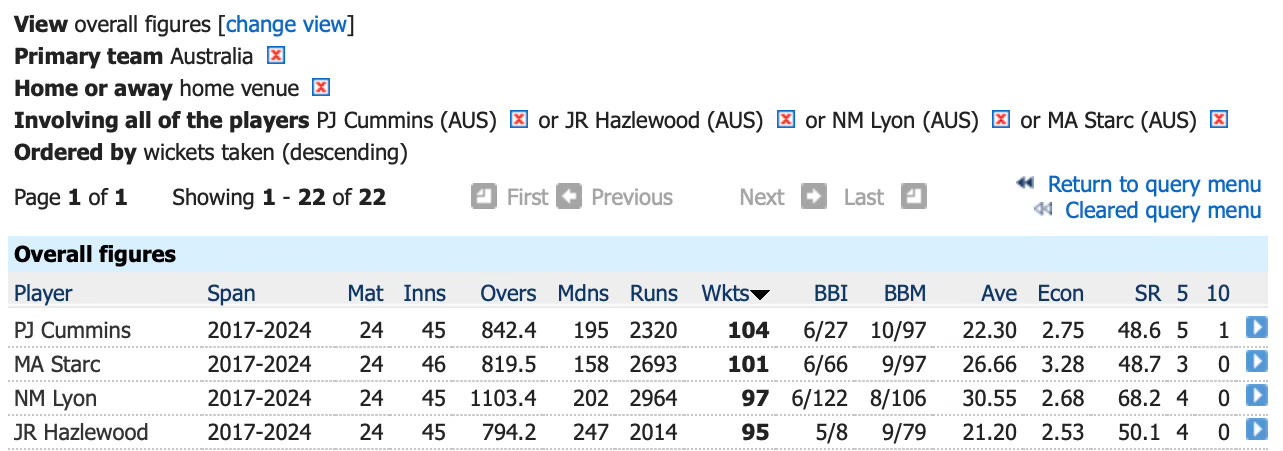Australia set up for Gabba revenge thanks to India's team selection & poor execution by batters
Barring rain or a miraculous comeback from India, Australia look comfortable to lift the Border Gavaskar Trophy after nearly 10 years.
At the time of writing, India finds itself in deep trouble at 228/9, 217 runs behind Australia’s 1st innings total with more than a day to go. Let’s look at various aspects that have brought the match to this point.
The bowling effort & team selection
Having put Australia to bat, India didn’t start the rain-curtained first day very well. The bowling was a touch wayward and short too. Even the next day, when the bowlers found their rhythm, many commentators mentioned the need to pitch it further up more often and try to have the stumps in play, due to the extra bounce at offer. However, making such an adjustment for each venue/pitch on the fly isn’t easy, unless you are Jasprit Bumrah.
Changing the length that comes naturally to you, something that has been practiced over tens of FC matches, and thousands of balls, is quite tough. While the length adjustment was made, they probably didn’t have the same accuracy they would in India. Overall though, Jasprit Bumrah, Mohammed Siraj, and Akash Deep bowled pretty well, producing plenty of chances, and keeping the run flow to a minimum. Akash Deep, making his Australia debut, was particularly unlucky having beaten nearly every batter (including Steve Smith) multiple times without any reward.
Australia managed just 104/3 after 43 overs after the first full session of the match, thanks to the disciplined bowling. Batting with a 35-over Kookaburra ball gets simpler. The ball is softer, doing fewer tricks, and Steve Smith and Travis Head were in a good position to capitalize. With the main 3 pacers needing rest, India had to turn to Nitish Reddy and Ravindra Jadeja.
Ravindra Jadeja had a bit of a shocker with the ball. The conditions were not going to be in his favor, but he never found his rhythm and leaked runs at more than 4 runs an over. R Ashwin, in a similar situation in the last game, kept things tight, conceding less than 3 an over despite Head’s attack, took a wicket, and produced some other chances too. Despite Jadeja’s improved batting, was there a need to rotate the spinner after Ashwin had done quite well? His lack of effectiveness put too much pressure on India’s main bowlers and youngster Nitish Kumar Reddy.
Before this test, Nitish Reddy had been used for just 13 overs across 197 overs bowled by India in the previous 2 tests. Did captain Rohit Sharma and team management trust Reddy’s bowling enough to use him as a full-time bowler? Probably not, but they were left with no choice since they had to rest the main 3 pacers. Not only did this allow Australia to bat India out of the game, but it put an immense load on Bumrah & Siraj. Bumrah already confirmed Siraj was bowling with a niggle, and there’s a good chance one of them (maybe both) doesn’t last all 5 tests.
It’s important to look back at how India won in the 2018-9 and 2020/1 editions of this series to understand what worked for India in the past. In 2018, India’s bowling line-up of Jasprit Bumrah, Mohd. Shami and Ishant Sharma were fit and close to their (collective) peak. They were ably supported by spinners R Ashwin, Jadeja, and youngster Kuldeep Yadav. The Indian batting line-up was close to their peak as well, and without taking credit away from them, the Australian attack of Starc-Hazlewood-Cummins-Lyon had half the experience they have today. Cummins had only played about 15 tests at the start of that series.
Since then, this Aussie line-up has become a master in most conditions. They have gone to incredibly flat conditions in Pakistan and emerged as winners. They have over 500 test wickets playing together, with close to 80% of those coming at home. To add to that, they play only at 5 test venues. They know exactly the lengths to bowl at each of these venues. With these four in the line-up, when Australia has scored more than 300 in the 1st innings of a Test, their record is 11 wins, 1 loss, and 1 draw. (The last 2 results were the last two tests of the 2020/1 series.)
In 2020/1, despite losing many stars (Shami, Umesh, Ishant, and Kohli) early in the series, India fought brilliantly to keep the series at 1-1 until the 3rd game. Playing with many new faces in the 4th test at Gabba, they had a lot of luck going their way with instances such as lower bats putting together crucial partnerships and Pant surviving a missed stumping in that 4th innings. It was a miracle for an attack with less than 10 test caps to compete and then beat one with 1000+ test wickets.
Barring a similar miracle, India needed to pick 4 front-line bowlers, just like they have done for close to a decade under Kohli, Rahane, and even Rohit. Instead of going for a frontline bowler like Prasidh Krishna, or even Harshit Rana (by playing him as 4th seamer with less pressure), India went with a 4th bowling option who was trusted with just 13 overs out of India’s 197 in the previous two tests.
Were Indian bowlers going to compete with a set of Aussies that average 25 and take a wicket every 9 overs over 397 wickets at home?
It was always unlikely, but Jadeja’s poor outing, some bad luck, and Nitish Reddy’s selection cost them an additional 100-120 runs. At that point, the only option in this rain-curtailed match was a draw, either by batting big or by avoiding the follow-on.
The batting effort
With 445 on the board, the first task for Indian batters was to try and get 250 to avoid the follow-on. The talented southpaw Yashavi Jaiswal came out to bat with intent, quite literally from ball 1. Considering his natural game and quality, batting with intent is not a problem generally.
But with the rain around the corner and the knowledge that scoring is going to be much easier after 30 overs, there was a need for more patience. What’s frustrating is that the same batter has shown incredible temperament in the 2nd innings of the series. In Perth, Jaiswal did not play a single full-blooded drive until the 57th delivery he faced and went on to score a massive 150. Yet he has somehow changed his method since.
The other youngster, Shubman Gill, also went for an extravagant drive pretty early in his innings. In his case though, he was timing the ball superbly from the 1st ball in the previous test and probably brought in that confidence with him. Plus he was dismissed by a Mitch Starc jaffa who pitched at the same length in the previous innings, so for him to try and play that is still understandable.
KL Rahul has been the only batter who has looked consistently solid in this series. He hasn’t converted every start, but he has stuck to his method, played the ball late, and tried to play close to the body. Of course, he’s had some luck but against this quality of bowling, on juicy pitches like these, every batter (like Steve Smith and Travis Head) needs some luck.
Virat Kohli, post that 100 at Perth in an easier situation, and skipper Rohit Sharma’s form hasn’t looked very good. To be fair to them, they have gotten a couple of unplayable deliveries in this series, but besides that, there needs to be better application for sure. Kohli’s weakness outside the off-stump continues to be exploited, while Rohit’s sudden dip in form this year has been hard to explain. India started the transition to new bowlers under Dravid, once India is out of WTC Final contention, this team management must start pushing out the two senior batters in a similar fashion. (Although knowing India’s history of handling star players, that’s quite unlikely.)
Overall, India's batters in this series have been disappointing. With a mixture of youth, tough conditions, and a couple of players well past their peak, India’s batting hasn’t been producing as many runs for the last 2-3 years, so this performance is not surprising.
Having said all that about India’s bleak batting returns, there’s little doubt in my mind that we were behind the game due to the selection and Jadeja’s poor outing. The batting could have potentially saved the game, but to win games teams need to pick a deeper bowling line-up and allow opposition batters to bat freely after playing out the top 3 bowlers.





